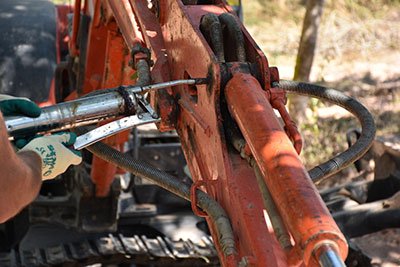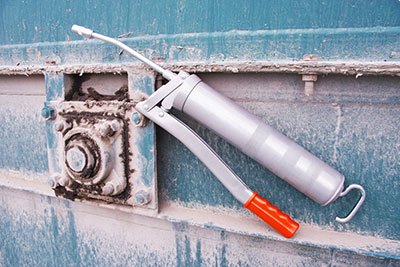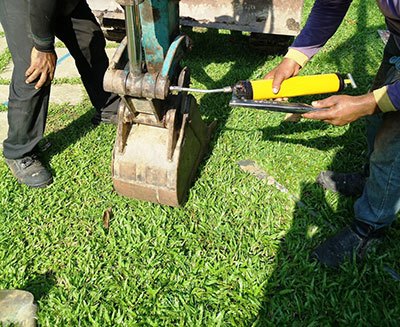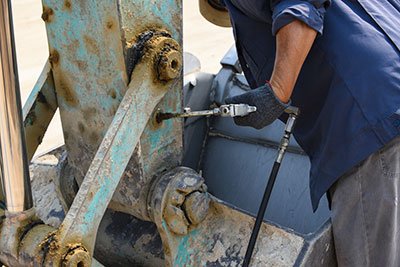Are you an agriculture worker or own a tractor? To keep your machinery functioning at its best, proper lubrication and maintenance are essential.
One key element of maintaining your tractor & other machines is greasing them regularly with the help of a grease gun.
But do you know how to use a grease gun correctly for achieving optimum results in machinery operations? If not, then no worries – we’ve got your back!
Here’s a comprehensive guide that explains everything about loading up and using a grease gun like an expert!
Take away key points:
- Learning how to load a grease gun helps you accomplish different farming tasks easily, and keep your machines optimal
- Before inserting a new grease, ensure you empty cartridge and then add the new lubricant
- Ensure you follow the steps below for the best usage
Table of Contents
- How to load grease guns? The best step-by-step procedure
- What are the disadvantages if you don’t load a grease gun properly?
- FAQs
- How do you lock a grease gun?
- How do you unlock a grease gun?
- How to add grease to a grease gun?
- How to load a high-pressure grease gun?
- How to load an m12 grease gun?
- How many cc’s are in the pump of the grease gun?
- How do you depressurize a grease gun?
- How do you load a Dewalt cordless grease gun?
- How to refill a Lubrimatic grease gun?
- Conclusion
How to load grease guns? The best step-by-step procedure
To use a grease gun properly, you must load it correctly and prepare all the parts to ensure the best greasing process for vehicle maintenance.
Refer to the detailed steps to help you grease equipment for different operations.
Method #1: Loading a reservoir grease gun

To ensure the best loading process of a reservoir grease gun, follow the thorough steps below:
Step 1: Separating the grease gun head from the barrel
To provide a more efficient loading of the bulk grease container, begin by unscrewing the grease gun head from the end cap. This head consists of a handle and applicator tube.
Afterward, separate the two pieces of the grease gun. Be sure to fully depress the handle on the back of the barrel. It is connected to the piston rod. Depress it to the barrel to avoid any accidental suctioning of grease through the gun.
Step 2: Inserting the open end of the barrel into the grease container
To fill the barrel of the grease guns, hold the open end down into the bulk container of grease and slowly draw back on the plunger rod. The process will siphon the loading grease back into its reservoir.
Bulk containers for most grease guns are widely available at hardware and auto parts stores, making them a great option for serious mechanics or garages that need to handle large amounts of bulk grease.
Step 3: Removing the barrel from the grease
When the plunger rod handle has been completely withdrawn, lift the open end of the barrel out of the container. Give it a few turns to break away any excess grease that may have stuck to the outside. Wipe excess grease off with a cloth or rag.
Step 4: Reattaching the grease gun barrel to the grease gun head
Depending on the type of grease gun you are using, the end cap or nozzle may need to be screwed onto it. Ensure that the threads fit and engage properly before turning them until it is fully seated in place.
Step 5: Testing the grease dispensing
To deliver grease, press down on the plunger rod handle and squeeze the trigger of the gun. After this, wipe away any excess grease from both the tip of the tube and the body of the gun.
Wipe down the entire grease gun, grease fittings, and other pumping equipment for the best oil process. Use a cloth or rag to clean the grease gun before use. Of course, wear rubber gloves to save your hands from dirt.
Method #2: Loading a grease cartridge

If you need to load your grease cartridge, refer to the step-by-step procedure below. Pay attention to every detail to ensure the best loading process.
The main steps include:
Step 1: Unscrewing the grease cartridge cap
Cartridge loaders consist of two main parts: a cartridge containing the grease and a housing with a dispenser or nozzle used to extrude the grease.
To remove the old cartridge, you need to unscrew the cap while turning the nozzle in the opposite direction (counterclockwise). It may require some effort to loosen it; use your strength.
Step 2: Pulling back on the metal handle
At the end of the barrel, opposite the nozzle, you’ll find a plunger rod used to push on the cartridge and expel the grease. Slowly pull it back until it has been fully removed from the barrel.
On certain grease guns, this should make the cartridge eject automatically. It may come out partially or completely depending on any buildup within. Before removal, be sure to secure the plunger rod in the right place.
Step 3: Securing the piston rod & removing the grease cartridge
On many grease guns, the piston rod can be shifted sideways slightly into a groove in the barrel so that it stays still.
In certain guns, when the piston rod has been retracted all the way, it will latch securely into place. A release tab is also present to allow it to be moved again. Once secured, you can pull out the spent cartridge and discard it.
Step 4: Preparing the new cartridge for loading
New grease gun cartridge models are available at most hardware and auto parts stores, usually in 14 oz (414 ml) or 16 oz (473 ml) sizes.
Clean the gun’s end with a cloth or rag before loading a new cartridge to remove any leaked-out grease from the prior one. You can also empty cartridge to ensure the new grease cartridge is optimal.
Before inserting the new grease cartridge, take off the plastic cap from one end of it to dispense grease and make it flow out. You will release the trapped air and prevent air pockets. Many people store their cartridges upside down as this aids in getting the grease near the nozzle.
However, if it hasn’t been stored this way, shaking it hard once or twice toward the cap will help it settle correctly before oil insertion.
Step 5: Inserting the cartridge into the barrel
Push the end of the cartridge with the plastic cap on it into the barrel first and make sure that the cartridge is fully inserted. It will seal with the barrel. Then, take off and discard the metal seal from the exposed end of the cartridge.
Step 6: Re-assemble the barrel to the grease gun head
Partially screw the head and barrel together, two full rotations but don’t fully tighten them. Then release the piston rod from its retracted position.
Simultaneously push it into the barrel while pumping the handle of the grease gun nozzle. This helps the trapped air to flow through the grease gun and plunger rod mechanism and get the grease begins its flowing.
Stop when you see grease appearing at the dispensing nozzle and the trapped air coming out. Continue screwing together the grease gun head and barrel.
In addition, push on the piston rod to make sure it is fully engaged in the replacement grease gun cartridge. Finally, pump out some grease from the grease gun handle to ensure that your grease equipment is working properly.
What are the disadvantages if you don’t load a grease gun properly?

Grease guns are common tools used in many industries, but they can be dangerous if not used properly. Loading a grease gun incorrectly can lead to several disadvantages, such as grease fitting points, over-lubrication, and even injury.
When loading a grease gun, it is important to ensure that the cartridge is properly inserted into the barrel of the gun. If the cartridge is not inserted correctly, it can cause clogging in the grease fitting points or blockages in the barrel of the manual grease gun.
This can lead to poor lubrication and damage to the tube, plunger, spring, and other equipment parts. Additionally, improper loading of a grease gun can result in over-lubrication which can cause excess wear on grease gun parts and reduce their lifespan. So, you won’t properly oil your machine.
Finally, improper loading of a grease gun can also lead to injury due to pressure build-up within the chamber and tube of the grease gun. This pressure build-up can cause air pockets and an explosion when releasing the trigger or when disconnecting from a grease fitting.
To avoid these risks, it is important to ensure that you follow all safety instructions when loading your grease gun and always wear protective gear while using it.
In conclusion, proper loading of a grease gun is essential for safe operation and avoiding potential hazards associated with its use. It is important to take all necessary precautions.
When using the grease gun, ensure that you get optimal performance from your equipment and avoid any potential injuries or damages caused by incorrect use.
FAQs
How do you lock a grease gun?
To lock the grease gun, follow the steps below:
– Apply manual pressure
– Pull the t-pull so the following rod comes back out of the barrel
– Pull it straight down and twist it 1/4 or 1/2 turn.
– You can feel it pop down and lock in place
How do you unlock a grease gun?
After pulling the t-pull down to lock it, pull the back and twist the plunger to unlock it. Slowly push the old cartridge from the grease gun body.
How to add grease to a grease gun?
Once you purchase the right grease, insert the new cartridge into your grease gun. Pull back the plunger on the grease gun, and then insert the cartridge into the body of your grease gun.
Screw on the barrel to make it stable and secure in the right place. Also, pumping a small amount of grease and wiping excess grease is necessary before you apply the grease to your machine.
How to load a high-pressure grease gun?
Follow the steps below:
– Select the right type of grease for your application.
– Fill the gun’s head with the appropriate amount of grease and attach the barrel over the grease tub.
– Point the barrel downward about 5 cm and pump the handle until pressure builds up in the gun. Once pressure has built up, you can begin greasing your desired area.
– Open the by-pass valve one full turn to relieve pressure before storing your grease gun.
– Wipe off any excess grease from the nozzle and cover it with a cap for storage.
How to load an m12 grease gun?
Remove the battery pack from the grease gun. Unscrew and remove the barrel from the handle. You can now either use a suction method or manually fill it with grease.
For suction loading, attach a grease loader fitting into the gun’s barrel and insert a new cartridge of grease into the fitting. Then, press down on the plunger until all of the air is removed from the inside of the barrel. Finally, pull back on the plunger to create a vacuum that will draw in fresh grease from the cartridge.
If you’re manually filling your gun with grease, simply unscrew and remove its cap before inserting a tube of grease into its opening. Then, press down on its plunger until all of the air is removed from inside of its barrel before pulling back on it to draw in fresh grease from its tube.
How many cc’s are in the pump of the grease gun?

Lever-style grease guns typically dispense 1.28 grams of grease per pump, while hand-grip-style grease guns dispense 0.86 grams per pump.
The capacity of a manual push-type grease gun is typically 125 cc, and professional lever grease guns come in two sizes: 400 cc bulk/14 oz cartridge and 500 ccs bulk/16 oz cartridge.
How do you depressurize a grease gun?
Attach the end of the hose or coupler to an empty tube. Loosen the fitting at the end of the hose and allow any pressure to escape. Close the fitting and store the grease gun in a horizontal position in a clean, cool, and dry area.
How do you load a Dewalt cordless grease gun?
Follow the steps below:
– Attach the cartridge to the gun.
– Unscrew the cap from the back of the gun and insert the cartridge into the chamber.
– Screw the cap back on securely.
– Press down on the plunger at the top of the gun until it clicks into place. This will prime the pump and allow you to start pumping grease.
– Pull back on the trigger to begin pumping grease out of your gun.
How to refill a Lubrimatic grease gun?
Follow the process below:
– Remove and discard the older cartridge.
– Insert the bottom tube of the new cartridge into the nozzle of the grease gun.
– Pull back the plunger and press down on it until it clicks in place.
– Start pumping the handle to fill up your grease gun with fresh lubricant.
Conclusion
Loading a grease gun is not a complex process. It requires careful attention to detail to ensure correct lubrication and smooth operation of your machine.
Once the procedure has been completed, you can trust that your equipment will be properly greased. So it functions efficiently for its intended purpose.
